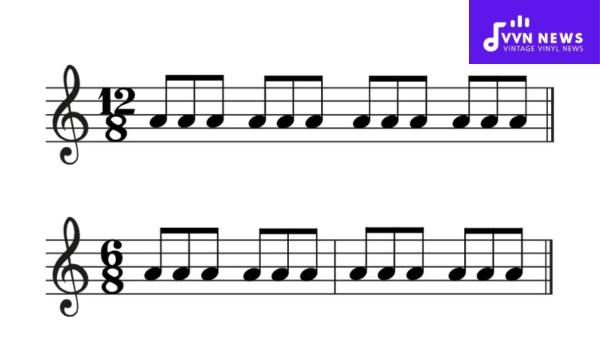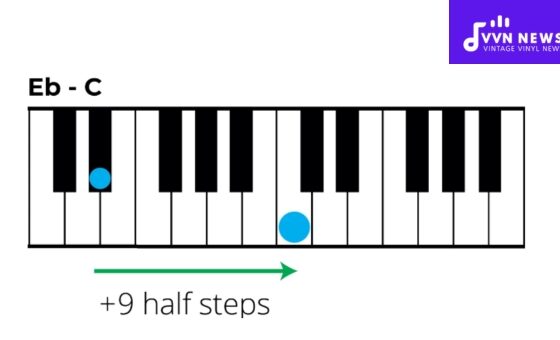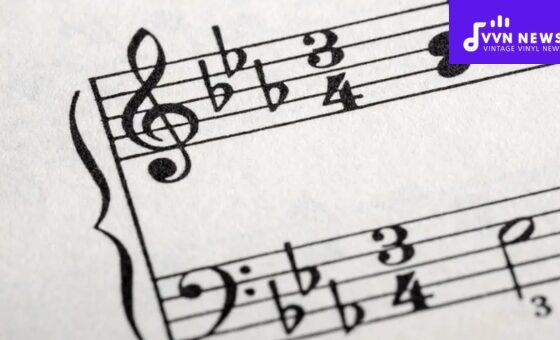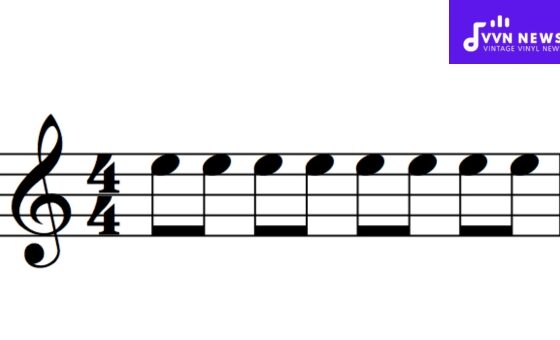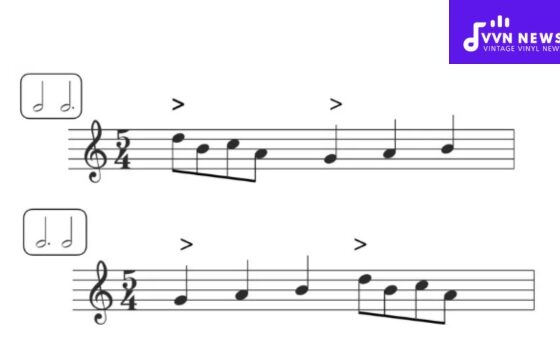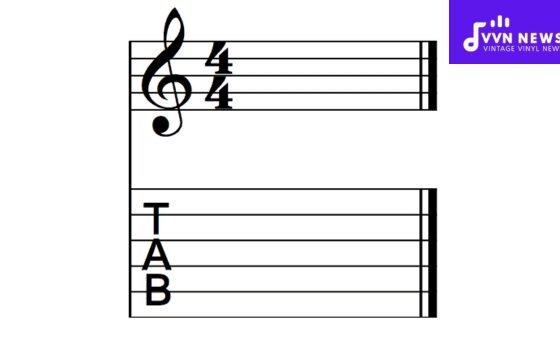The dynamics of music can often feel like trying to decipher a foreign language. But, like any language, once you begin to grasp the basics, the beauty and depth that awaits you is striking.
Factors like rhythm, pitch, and tempo are crucial, but there’s one element that sometimes gets overlooked: the time signature.
Central to this discussion is a rather interesting one-time signature 12/8. Now, for both newcomers to music theory and seasoned enthusiasts alike, time signature 12/8 may not be immediately familiar.
Yet this rhythmic pattern forms the backbone of many beautiful musical pieces across genres from classical symphonies to rock ballads.
The purpose of this blog is not only to explain what 12/8 means in terms of notes and beats but also how it lays the ground for creating a unique melody that impacts your overall musical experience.
What does the time signature 12/8 signify?
The 12/8 time signature denotes that there are 12 beats in a measure, and the eighth note is equivalent to one beat.
This pattern is often found in genres like blues and doo-wop as well as classical music. Essentially, you can think of the 12/8 time signature as having four main beats, each divided into three sub-beats.
When reading sheet music, this division helps musicians quickly identify rhythms and maintain consistent tempo while noting variations. It transforms a composition into a rhythmic dance between notes, providing depth to the melody line in unexpected ways.
Also Read: F Sharp Major Triad [Enhance Your Musical Compositions]
How does one count in a 12/8 time signature?
To count in a 12/8 time signature, view the rhythm as having four sets of triplets. Given that there are 12 eighth notes per measure, you’d count the beat as follows:

- 1 – triplet, 2 – triplet, 3 – triplet, 4 – triplet
For each number (1 through 4), you are essentially counting one beat split into three eighth notes—hence the “triplet”.
In practice, every first note of these triplets (the numbers themselves) represents a stronger downbeat. So it’s like counting three times within each beat while maintaining four main beats per bar.
This creates a smooth flow and highlights how 12/8 is felt more like a quadruple meter despite its numerous sub-divisions.
What Characterizes a Compound, Quadruple Time Signature Like 12/8?
Time signatures are the musical map that guides us through the rhythm of a song. 12/8 is known as a compound quadruple time signature. Here’s why:
- Compound: This term signifies that each beat can be divided into three equal parts instead of two. In the case of 12/8, one beat consists of a dotted quarter note, which can further be subdivided into three eighth notes.
- Quadruple: This refers to there being four beats in each measure. With 12/8 specifically, there are four dotted quarter notes per bar.
Think about it this way: while a simple time signature like 4/4 contains four beats typically subdivided into two eighth notes, 12/8 offers a richer texture with twelve eighth notes making up four broader pulses. Visually depicted:
Experiencing this time signature is akin to feeling a wave-like sway within the music—a lilting motion that propels the melody with a distinctive flow.
What are some songs that utilize the 12/8 time signature?
When you delve into the world of music, the 12/8 time signature serves as an enchanting rhythmic pattern present in many beloved songs.
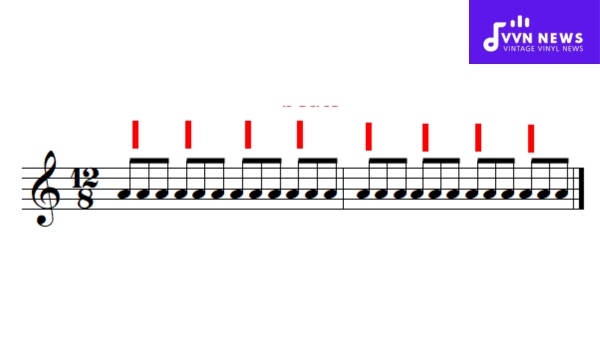
Encompassing a smooth and flowing feel, this compound meter injects a distinctive sway into music that’s hard to miss once you’re aware of its existence. Let’s explore some iconic tracks that exemplify this rhythm:
- “When A Man Loves A Woman” by Percy Sledge
This soulful classic is drenched in emotion, with a pulsating 12/8 beat that mirrors a heartbeat. It’s slow and deliberate, each set of triplets contributing to the song’s pleading quality. - “We Are Champions” by Queen
While it’s not through-and-through in 12/8, Queen’s anthem transitions into this time signature during its guitar solo, demonstrating how artists can seamlessly weave different rhythms for dramatic effect. - “All Along the Watchtower” by Bob Dylan
Dylan’s original may not be as commonly known in its 12/8 glory compared to Jimi Hendrix’s version, but it carries an unmistakable shuffle that has inspired countless covers. - “What’d I Say” by Ray Charles
A rhythm and blues staple, Ray Charles injects the piano groove with quintessential 12/8 timing, giving those keys a jolt of life that demands your foot to tap along. - “Hallelujah” by Leonard Cohen
Immortalized through numerous renditions, Cohen’s “Hallelujah” captures a haunting beauty accentuated by the sweeping motion of a 12/8 meter—each chord change weighted with emotional heft.
By listening closely to these tracks, one can discern how composers utilize the “three beats per four measures”—a framework intrinsic to conjuring up the expressive ebb.
Also Read: E Major Triad [Master This Staple Of Music Composition]
How does ear training relate to understanding meters like 12/8?
Ear training is an essential skill for musicians, aiding in the recognition of rhythms and meters which are the scaffolding of music.
When it comes to complex time signatures such as 12/8, ear training becomes even more vital.
Identifying Patterns
Listening exercises can help you distinguish patterns typical to the 12/8 meter.
Engaging regularly with pieces that deploy this time signature conditions your ear to naturally identify the underlying triplet feel, characteristic of a grouping of four sets of three eighth notes.
Subdivisions Recognition
Developing your aural skills leads to a better appreciation for subdivisions within a measure.
This awareness is crucial in 12/8 since each beat is divided into three instead of two, which is more common in simple meters like 4/4.
Internalizing Pulse
Accurate ear training enables you to internalize the pulse of music. For a time signature like 12/8, this means sensing the broader ‘four-beat’ feel while simultaneously acknowledging the subtle ‘three-beat’ subdivisions—a key distinction from both duple and triple meters.
Accent Detection
In compound meters such as 12/8, certain beats are naturally accented or emphasized.
With trained ears, picking out these accents becomes second nature, allowing for an intuitive grasp of the pulsating essence specific to such time signatures.
Syncopation Sensitivity
Finally, mastering auditory perception through regular exercises aids in recognizing syncopation within complex meters.
In 12/8 rhythms, syncopation creates captivating tension and release; learning this rhythmic nuance enriches one’s musical lexicon immeasurably.
Honing your ear unlocks the ability to deconstruct and enjoy sophisticated rhythmic structures.
The compound quadruple cadence that defines 12/8 can add both a soulful groove and an orchestral breadth when perceived with well-trained ears.
What is the difference between the 12/8 and 6/8 time signatures?
Delving into the world of complex rhythms, it’s often easy to confuse similar-looking time signatures.
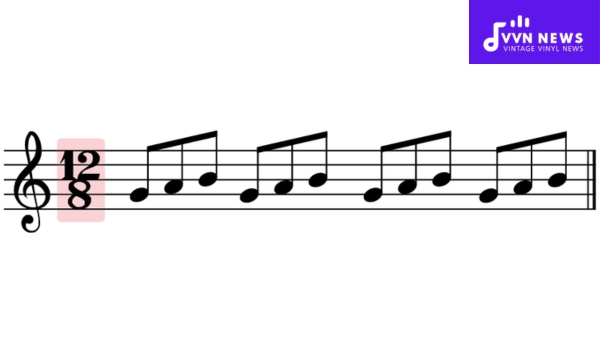
Below are five key differences between 12/8 and 6/8 that highlight their distinct musical textures:
- Primary Beats: In 12/8, there are four primary beats per bar, each subdivided into three. Contrastingly, 6/8 consists of two main beats per bar, also subdivided into three.
- Beat Grouping: Grouping in 12/8 is usually done in four groups of three eighth notes — think of it as a broader version of 4/4 but with a triplet feel. Whereas in 6/8, the grouping is emphasized as two sets of three eighth notes.
- Pulse: One can sense a stronger pulse in 12/8 due to its quadruple-time nature. This gives it a weightier feel compared to the duple meter pulse felt in 6/8.
- Musical Genres: Although both signatures may appear across various genres, you’ll often find the sweeping cadence of 12/8 in blues and gospel music. Meanwhile, the jaunty bounce of 6/8 is a staple in folk and ballads.
- Interchangeability with Simple Time: Due to its compound structure, you can switch between common time (4/4) and compound quadruple (12/8) keeping the pace unchanged. Swapping between simple duple (2/4) and compound duple (6/8) alters rhythmic feeling significantly.
Each signature carves out its unique atmosphere within compositions – knowing this not only enhances your listening pleasure but also opens up new dimensions if you’re crafting tunes yourself!
Also Read: How To Transpose Treble To Bass Clef [Music Guide]
How is there a link between the 4/4 and 12/8 time signatures?
At first glance, the 4/4 and 12/8 time signatures might seem quite dissimilar, but they share a closer relationship than one might think.
Both are commonly used in various music genres, creating grooves that are foundational to a vast array of songs.
Pulse and Subdivision
The primary link between 4/4 and 12/8 lies in their pulse and subdivision.
In 4/4 time, also known as common time, there are four beats to a measure, and each beat is represented by a quarter note. It is straightforward: one-quarter note equals one beat.
Conversely, 12/8 is a compound quadruple meter with twelve beats per measure, divided into four groups of three eighth notes.
Here’s where they intersect: the four beats in the measure correspond to the four quarter-note beats of 4/4 time.
But each beat in 12/8 is further broken down into what feels like a triplet feel within each beat.
Feel and Rhythmic Interpretation
Diving deeper into this connection reveals how rhythm is interpreted differently:
- In 4/4 time, musicians often maintain a steady pace while playing straight quarter notes.
- In 12/8, each of these main beats can be felt as if it has its own set of three rapid pulses (the ‘triplet’ feel), providing a different rhythmic flavor, more of a rolling or swinging sense than the straight-ahead pulse found in plain 4/4 rhythms.
The rhythmic correlation leads to an overlap where musical phrases written in one signature can be adapted to the other with slight adjustments in note values.
Adaptability Across Genres
For instance, blues musicians may take advantage of this link by playing shuffle rhythms typical for 12/8 within pieces notated in or traditionally played with a straight 4/4 time signature.
This adaptability across genres enables musicians to explore creative phrasing by superimposing these two meters upon each other.
With this knowledge of rhythmic compatibility, it’s clear that counting differs between them while revealing how adaptable rhythmic structures are across diverse musical landscapes.
It showcases an essential aspect of musical creativity: the flexibility within the structure that allows for expressive performance and composition.
Also Read: A Guide Transposing Into The Alto C [Navigate Music Transposition]
FAQs
What defines the time signature 12/8?
12/8 is a compound quadruple time signature, indicating that there are essentially four groups of three eighth notes in each measure. It’s as if you’re counting “1-2-3, 2-2-3, 3-2-3, 4-2-3.”
How do you tap out the rhythm for a song in 12/8?
To tap out the rhythm in 12/8, subdivide your beat into triplets, giving a slight emphasis on every first note to mark each new group of three.
Can you compare 12/8 with another common time signature in terms of feel?
While 4/4 feels steady and square with four even beats, 12/8 has a more rolling or swinging groove due to its triplet subdivision resembling a heartbeat with alternating strong and weak pulses.
Are there specific genres where I might encounter 12/8 more frequently?
Yes, blues and gospel music often feature the 12/8 signature, giving them their characteristic soulful lilt and swaying rhythm.
Could I confuse the 12/8 timing with another time signature when listening to music?
It’s possible to mistake it for others, particularly 6/8. Listen for longer phrases since two bars of 6/8 typically sound like one bar of 12/8, due to the latter’s broader feel.
Also Read: How To Transpose Music? [Simplifying Key Changes In Songs]
Conclusion
12/8 is more than a mere time signature; it’s a rhythmic framework that imparts depth and swing to music, creating an undeniable groove.
By knowing how to count in 12/8 and recognizing its feel, you’ll unlock the ability to both appreciate and create emotionally resonant compositions.
If you’re discerning the subtleties of a classical adagio or tapping your foot to a bluesy rock ballad, the quintessential pulse of 12/8 is unmistakable.
So next time you hear a song, see if you can identify this captivating meter. If you do, you’ll have uncovered another layer of the music’s heartbeat — its rhythm.
